
The spore print is the powdery deposit obtained by allowing spores of a fungal fruit body to fall onto a surface underneath. It is an important diagnostic character in most handbooks for identifying mushrooms. It shows the colour of the mushroom spores if viewed en masse.
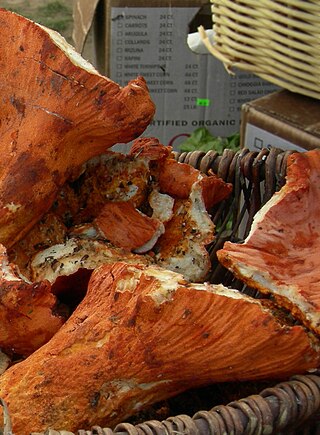
Hypomyces lactifluorum, the lobster mushroom, contrary to its common name, is neither a mushroom nor a crustacean, but rather a parasitic ascomycete fungus that grows on certain species of mushrooms, turning them a reddish orange color that resembles the outer shell of a cooked lobster. H. lactifluorum specifically attacks members of the genera Lactarius and Lactifluus (milk-caps), and Russula (brittlegills), such as Russula brevipes and Lactifluus piperatus in North America. At maturity, H. lactifluorum thoroughly covers its host, rendering it unidentifiable. Lobster mushrooms are widely eaten and enjoyed freshly foraged and cooked. They are commercially marketed and sometimes found in grocery stores; they have been made available at markets in Oregon. They have a seafood-like flavor and a firm, dense texture.

Russula is a very large genus composed of around 750 worldwide species of ectomycorrhizal mushrooms. They are typically common, fairly large, and brightly colored – making them one of the most recognizable genera among mycologists and mushroom collectors. Their distinguishing characteristics include usually brightly coloured caps, a white to dark yellow spore print, brittle, attached gills, an absence of latex, and absence of partial veil or volva tissue on the stem. Microscopically, the genus is characterised by the amyloid ornamented spores and flesh (trama) composed of spherocysts. Members of the related genus Lactarius have similar characteristics but emit a milky latex when their gills are broken. The genus was described by Christian Hendrik Persoon in 1796.
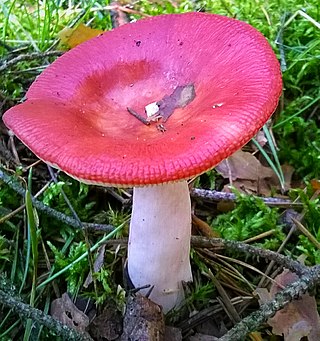
Russula emetica, commonly known as the sickener, emetic russula, or vomiting russula, is a basidiomycete mushroom, and the type species of the genus Russula. It has a red, convex to flat cap up to 8.5 cm (3.3 in) in diameter, with a cuticle that can be peeled off almost to the centre. The gills are white to pale cream, and closely spaced. A smooth white stem measures up to 10.5 cm (4.1 in) long and 2.4 cm (0.9 in) thick. First described in 1774, the mushroom has a wide distribution in the Northern Hemisphere, where it grows on the ground in damp woodlands in a mycorrhizal association with conifers, especially pine.
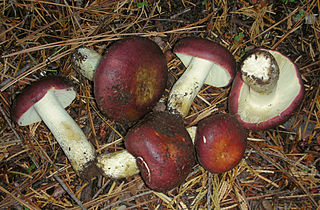
Russula xerampelina, also commonly known as the shrimp russula, crab brittlegill, or shrimp mushroom, is a basidiomycete mushroom of the brittlegill genus Russula. Two subspecies are recognised. The fruiting bodies appear in coniferous woodlands in autumn in northern Europe and North America. Their caps are coloured various shades of wine-red, purple to green. Mild tasting and edible, it is one of the most highly regarded brittlegills for the table. It is also notable for smelling of shellfish or crab when fresh.

Russula virescens is a basidiomycete mushroom of the genus Russula, and is commonly known as the green-cracking russula, the quilted green russula, or the green brittlegill. It can be recognized by its distinctive pale green cap that measures up to 15 cm (6 in) in diameter, the surface of which is covered with darker green angular patches. It has crowded white gills, and a firm, white stipe that is up to 8 cm (3 in) tall and 4 cm (1.6 in) thick. Considered to be one of the best edible mushrooms of the genus Russula, it is especially popular in Spain and China. With a taste that is described variously as mild, nutty, fruity, or sweet, it is cooked by grilling, frying, sautéeing, or eaten raw. Mushrooms are rich in carbohydrates and proteins, with a low fat content.

Russula cyanoxantha, synonymous with R. xyanoxantha, commonly known as the charcoal burner or variegated russula, is a basidiomycete mushroom, distinguished from most other members of the genus Russula by the fact that its gills do not split, but are soft and flexible. It is one of the most common species of Russula in Europe.

Russula nigricans, commonly known as the blackening brittlegill or blackening russula, is a gilled mushroom found in woodland in Europe. It gains both its common and scientific name from its propensity to turn black from cutting or bruising.

Russula sanguinaria, commonly known as the bloody brittlegill or rosey russula, is a strikingly coloured mushroom of the genus Russula, which has the common name of brittlegills. It is bright blood-red, inedible, and grows in association with coniferous trees. It was previously widely known as Russula sanguinea.

Russula brevipes is a species of mushroom commonly known as the short-stemmed russula or the stubby brittlegill. It is widespread in North America, and was reported from Pakistan in 2006. The fungus grows in a mycorrhizal association with trees from several genera, including fir, spruce, Douglas-fir, and hemlock. Fruit bodies are white and large, with convex to funnel-shaped caps measuring 7–30 cm (3–12 in) wide set atop a thick stipe up to 8 cm (3 in) long. The gills on the cap underside are closely spaced and sometimes have a faint bluish tint. Spores are roughly spherical, and have a network-like surface dotted with warts.
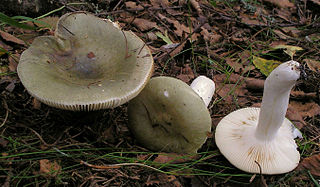
Russula aeruginea, also known as the grass-green russula, the tacky green russula, or the green russula, is an edible Russula mushroom. Widely distributed in northern temperate regions, it is usually found under birch, mostly in pine forests. The very poisonous death cap can have a similar appearance, especially from above.
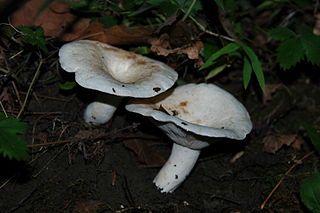
Lactifluus piperatus, commonly known as the blancaccio, is a semi-edible basidiomycete fungus of the genus Lactifluus. Despite being edible, it is not recommended by some because of its poor taste, though can be used as seasoning when dried. The fruiting body is a creamy-white mushroom which is funnel-shaped when mature, with exceptionally crowded gills. It bleeds a whitish peppery-tasting milk when cut. Widely distributed across Europe and eastern North America, Lactifluus piperatus has been accidentally introduced to Australia. Mycorrhizal, it forms a symbiotic relationship with various species of deciduous tree, including beech, and hazel, and fruiting bodies are found on the forest floor in deciduous woodland.

Russula fragilis, commonly known as the fragile russula, or fragile brittlegill, is a species of mushroom of the genus Russula, whose members are commonly known as brittlegills. It is a small, fragile, long stemmed, and variably coloured brittlegill, found in mixed forests, and woods in Europe, Asia, and North America.

Russula albidula is a species of mushroom in the genus Russula. The species, known in the vernacular as the boring white russula or the whitish brittlegill, is nondescript, with a small or medium dirty white fruit body, and a highly acrid taste. It is found in eastern North America.

Russula paludosa is an edible species of mushroom within the large genus Russula. It is common to Europe and North America.
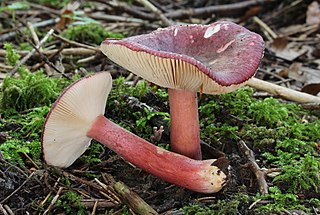
Russula queletii otherwise known as the gooseberry russula, is a common, inedible, Russula mushroom found growing in groups, predominantly in spruce forest. Eating this mushroom causes abdominal pains.
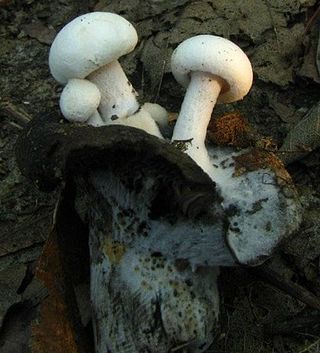
Asterophora lycoperdoides, commonly known as the star bearer, or powdery piggyback mushroom, is a species of fungus in the Lyophyllaceae family. It grows as a parasite on other mushrooms, mainly those in the genus Russula. Its gills are poorly formed or nearly absent. Asexual spores are produced on the mushrooms cap which enable the organism to clone itself easily. The spores are star-shaped, hence the name star bearer. It is regarded as nonpoisonous but inedible.

Russula densifolia, commonly known as the crowded russula or the reddening russula, is a species of agaric fungus in the family Russulaceae. It was first described in 1833 and given its current name in 1876. A widespread species, it is found in Asia, Europe, and North America, where it fruits on the ground in mixed and deciduous forests. Fruit bodies (mushrooms) are robust and squat, with caps up to 14.5 cm (5.7 in) in diameter, and stems that are 2–7.5 cm (0.8–3.0 in) long by 1.2–2.5 cm (0.5–1.0 in) thick. The mushrooms are characterized by the red and then black color changes that occur in the flesh when it is bruised, and a relatively thick cap cuticle. Although the mushroom is sold as an edible species in some areas of Asia, it is mild to moderately toxic, and may cause gastrointestinal upset if consumed. Several bioactive compounds have been isolated and identified from the mushroom.

Hygrophorus russula, commonly known as the pinkmottle woodwax, false russula, or russula-like waxy cap, is a fungus native to North America and Europe.

Russula subtilis is a basidiomycete mushroom of the genus Russula native to North America. Its flesh smells of parsley.



















